Tsoulfanidis N. Measurement and detection of radiation
Подождите немного. Документ загружается.

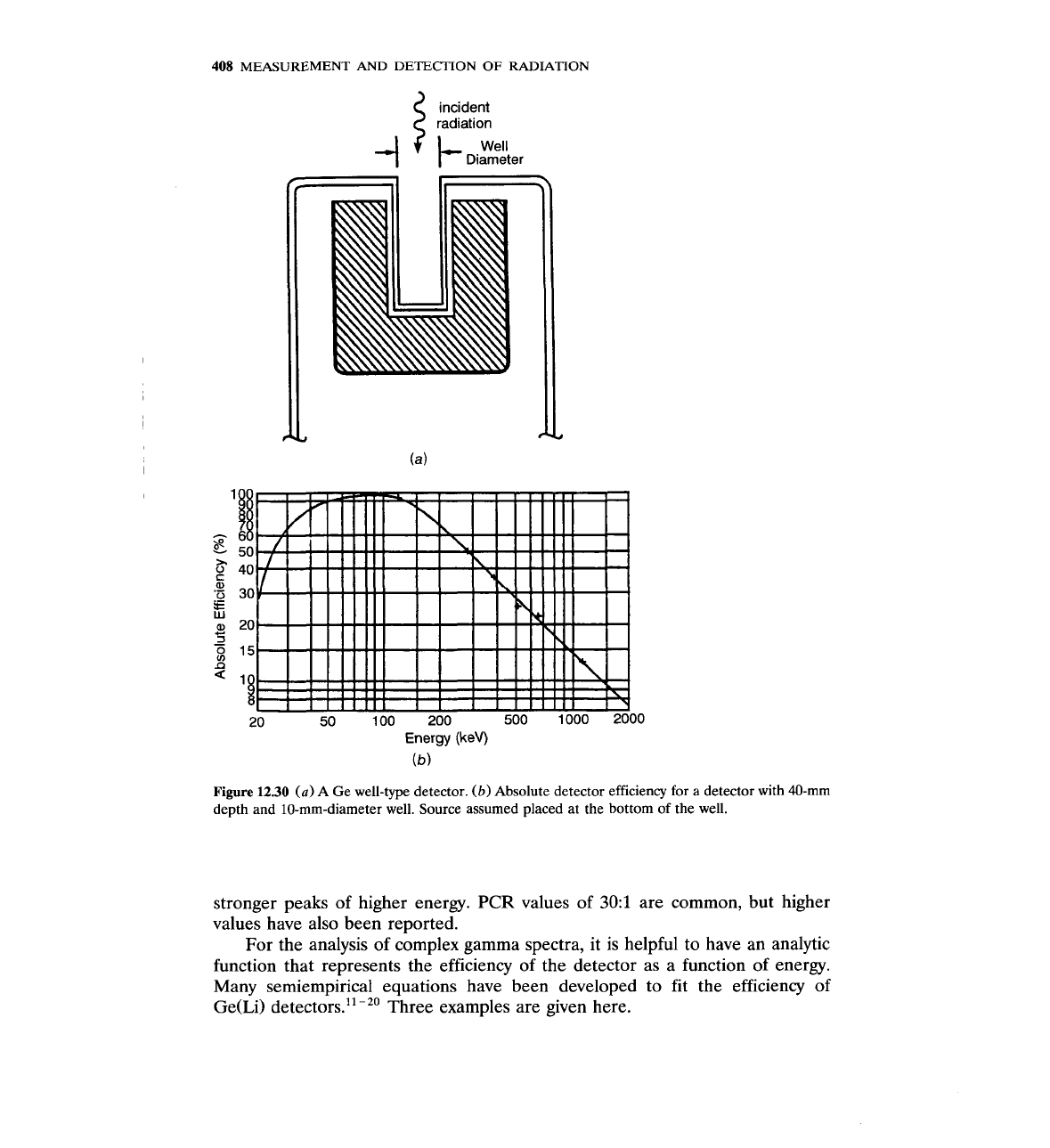
408
MEASUREMENT AND DETECTION OF RADIATION
incident
radiation
4
f'
We"
Diameter
Energy
(keV)
(b)
Figure
1230
(a)
A Ge well-type detector.
(b)
Absolute detector efficiency for a detector with 40-mm
depth and 10-mm-diameter well. Source assumed placed at the bottom of the well.
stronger peaks of higher energy.
PCR
values of
30:l
are common, but higher
values have also been reported.
For the analysis of complex gamma spectra, it is helpful to have an analytic
function that represents the efficiency of the detector as a function of energy.
Many semiempirical equations have been developed to fit the efficiency of
Ge(Li) detectors."-20 Three examples are given here.

PHOTON (GAMMA-RAY AND X-RAY) SPECTROSCOPY
409
Energy,
MeV
Figure
12.31
Photon attenuation coefficients for germanium. The dashed line is the approximate
total linear attenuation coefficient.
The Freeman-Jenkin
qua ti on".
where
r
=
photoelectric coefficient
x
=
thickness of the detector
u
=
Compton coefficient
A,
B
=
constants to be determined from measurement
Equation 12.8 was used to determine the
relative
efficiency of a cylindrical and
a
trapezoidal detector over the range
500-1500
keV, with an accuracy of about
1
percent.
The Mowatt Equation".
where
F'
=
lIi
exp
(-
pixi)
=
product of attenuation factors outside the intrin-
sic region
a,
=
normalization factor
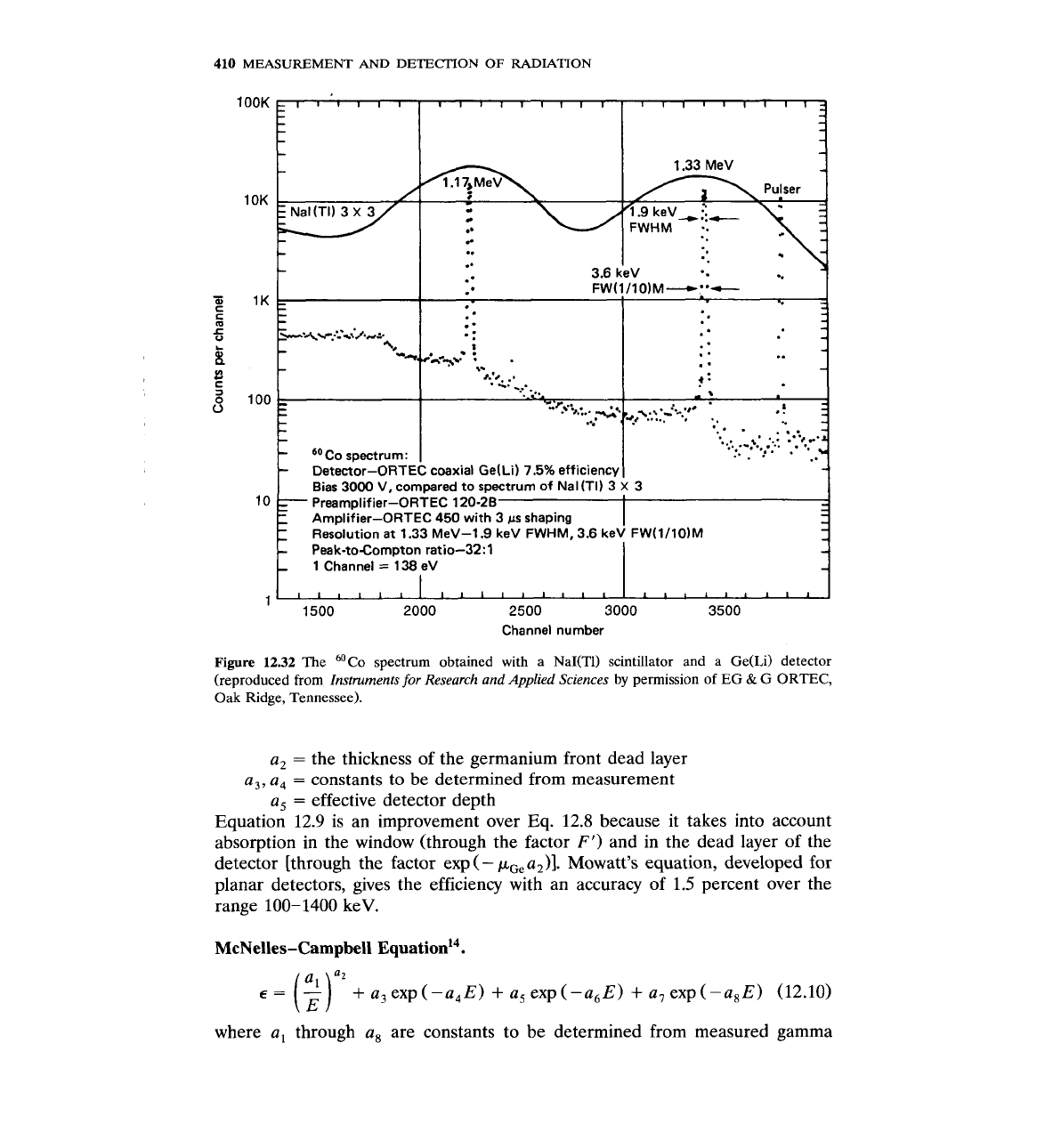
410
MEASUREMENT
AND
DETECTION
OF
RADIATION
1 OOK
1 OK
75
1K
C
c
r
k
a
loo
0
Bias 3000 V, compared to spectrum of Nal(TI)
3
x
3
Preamplifier-ORTEC 120-26
Amplifier-ORTEC 450 with 3 ps shaping
Peak-toCompton ratio-32:l
1
Channel
=
138 eV
lI1lllllllllllllllllllllllllj
1500 2000 2500 3000 3500
Channel number
Figure
12.32
The 60~o spectrum obtained with a NaI(T1) scintillator and a Ge(Li) detector
(reproduced from
Instruments for Research and Applied Sciences
by permission of EG
&
G
ORTEC,
Oak Ridge, Tennessee).
a,
=
the thickness of the germanium front dead layer
a,,
a,
=
constants to be determined from measurement
a,
=
effective detector depth
Equation 12.9 is an improvement over Eq. 12.8 because it takes into account
absorption in the window (through the factor
F')
and in the dead layer of the
detector [through the factor exp(-
p,,a,)].
Mowatt's equation, developed for
planar detectors, gives the efficiency with an accuracy of 1.5 percent over the
range 100-1400 keV.
where
a,
through
a,
are constants to be determined from measured gamma
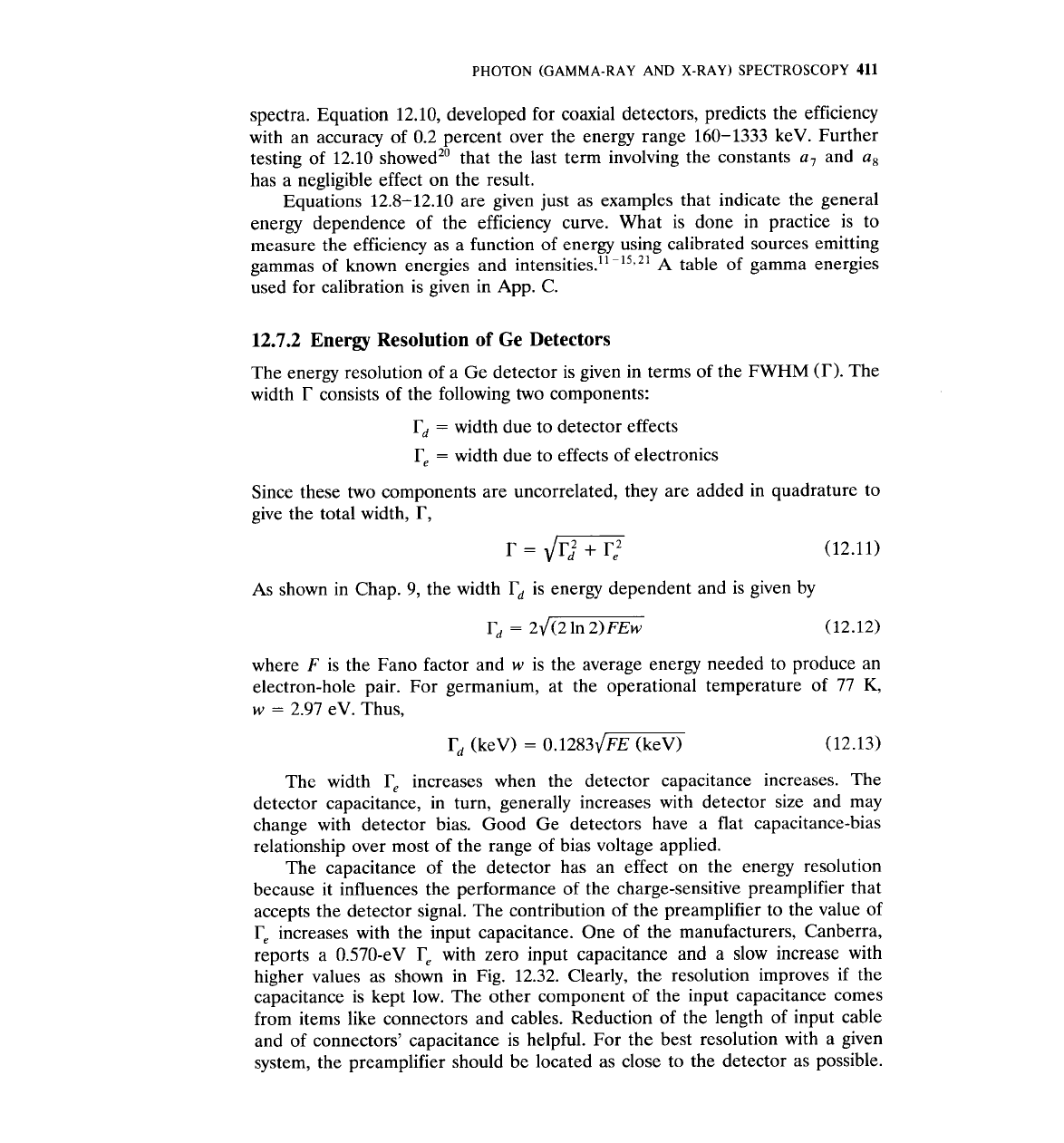
PHOTON (GAMMA-RAY AND X-RAY) SPECTROSCOPY
411
spectra. Equation 12.10, developed for coaxial detectors, predicts the efficiency
with an accuracy of 0.2 percent over the energy range 160-1333 keV. Further
testing of 12.10 showed2' that the last term involving the constants
a,
and
a,
has a negligible effect on the result.
Equations 12.8-12.10 are given just as examples that indicate the general
energy dependence of the efficiency curve. What is done in practice is to
measure the efficiency as a function of energy using calibrated sources emitting
gammas of known energies and
inten~ities."-'~.~'
A
table of gamma energies
used for calibration is given in App. C.
12.7.2
Energy Resolution of Ge Detectors
The energy resolution of a Ge detector is given in terms of the FWHM
(r).
The
width
r
consists of the following two components:
r,
=
width due to detector effects
re
=
width due to effects of electronics
Since these two components are uncorrelated, they are added in quadrature to
give the total width,
T,
r=,/m
(12.11)
As shown in Chap.
9,
the width
T,
is energy dependent and is given by
where
F
is the Fano factor and
w
is the average energy needed to produce an
electron-hole pair. For germanium, at the operational temperature of
77
K,
w
=
2.97 eV. Thus,
The width
re
increases when the detector capacitance increases. The
detector capacitance, in turn, generally increases with detector size and may
change with detector bias. Good Ge detectors have a flat capacitance-bias
relationship over most of the range of bias voltage applied.
The capacitance of the detector has an effect on the energy resolution
because it influences the performance of the charge-sensitive preamplifier that
accepts the detector signal. The contribution of the preamplifier to the value of
re
increases with the input capacitance. One of the manufacturers, Canberra,
reports a 0.570-eV
re
with zero input capacitance and a slow increase with
higher values as shown in Fig. 12.32. Clearly, the resolution improves if the
capacitance is kept low. The other component of the input capacitance comes
from items like connectors and cables. Reduction of the length of input cable
and of connectors' capacitance is helpful. For the best resolution with a given
system, the preamplifier should be located as close to the detector as possible.
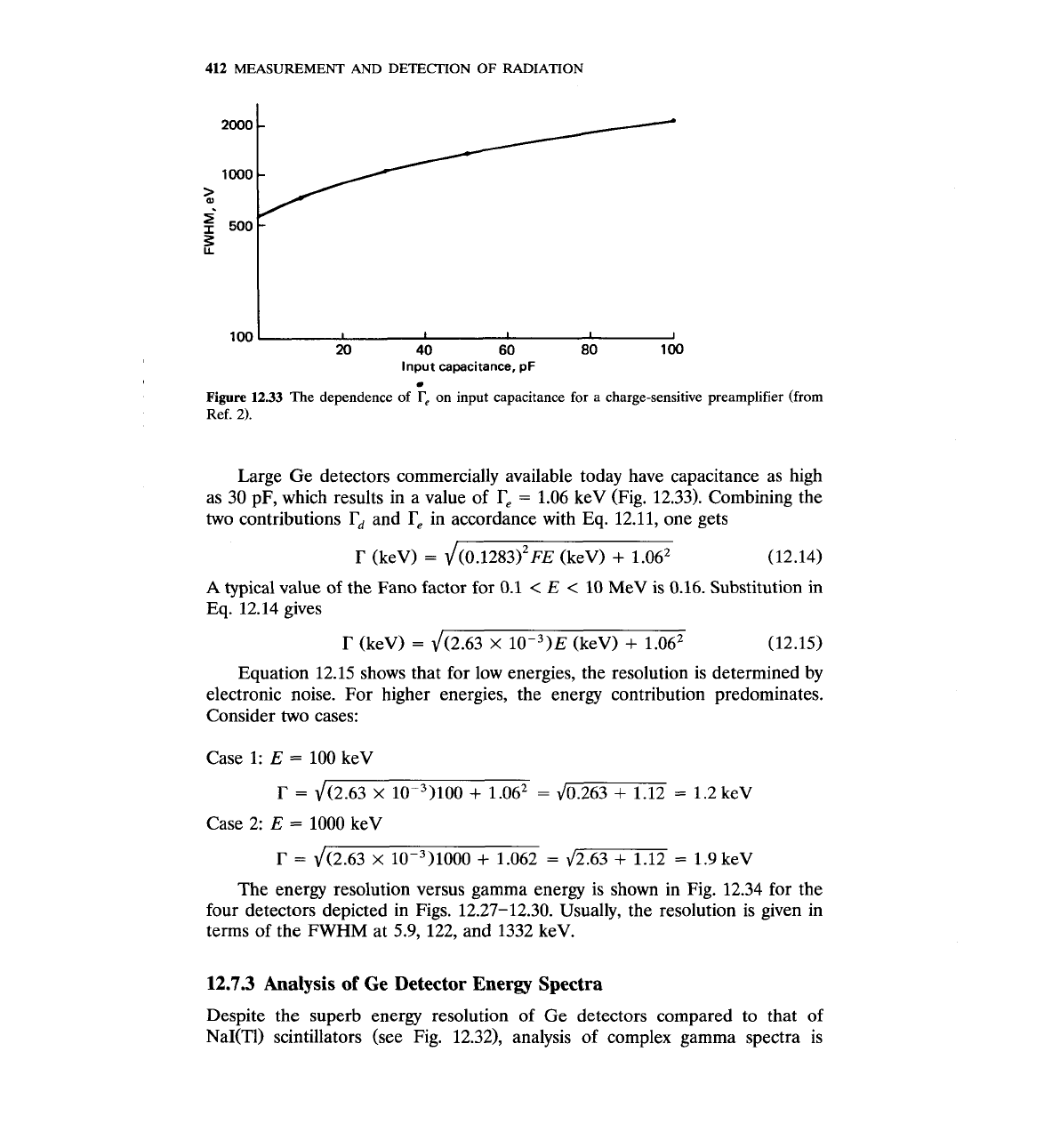
412
MEASUREMENT
AND
DETECTION
OF
RADIATION
I
1
I
I
I
20
40
60
80
100
Input capacitance, pF
Figure
12.33
The dependence of
re
on input capacitance for a charge-sensitive preamplifier (from
Ref.
2).
Large Ge detectors commercially available today have capacitance as high
as 30 pF, which results in a value of
re
=
1.06 keV (Fig. 12.33). Combining the
two contributions
r,
and
re
in accordance with
Eq.
12.11, one gets
r
(keV)
=
d(0.1283)~~~ (keV)
+
1.062
(12.14)
A
typical value of the Fano factor for 0.1
<
E
<
10 MeV is 0.16. Substitution in
Eq. 12.14 gives
r
(keV)
=
J(2.63
x
lop3
)E (keV)
+
1.06~ (12.15)
Equation 12.15 shows that for low energies, the resolution is determined by
electronic noise. For higher energies, the energy contribution predominates.
Consider two cases:
Case
1:
E
=
100 keV
Case 2:
E
=
1000 keV
4
for the
The energy resolution versus gamma energy is shown in Fig. 12.3,
four detectors depicted in Figs. 12.27-12.30. Usually, the resolution is given in
terms of the
FWHM
at 5.9, 122, and 1332 keV.
12.7.3
Analysis
of
Ge Detector Energy Spectra
Despite the superb energy resolution of Ge detectors compared to that of
NaI(T1) scintillators (see Fig. 12.32), analysis of complex gamma spectra is
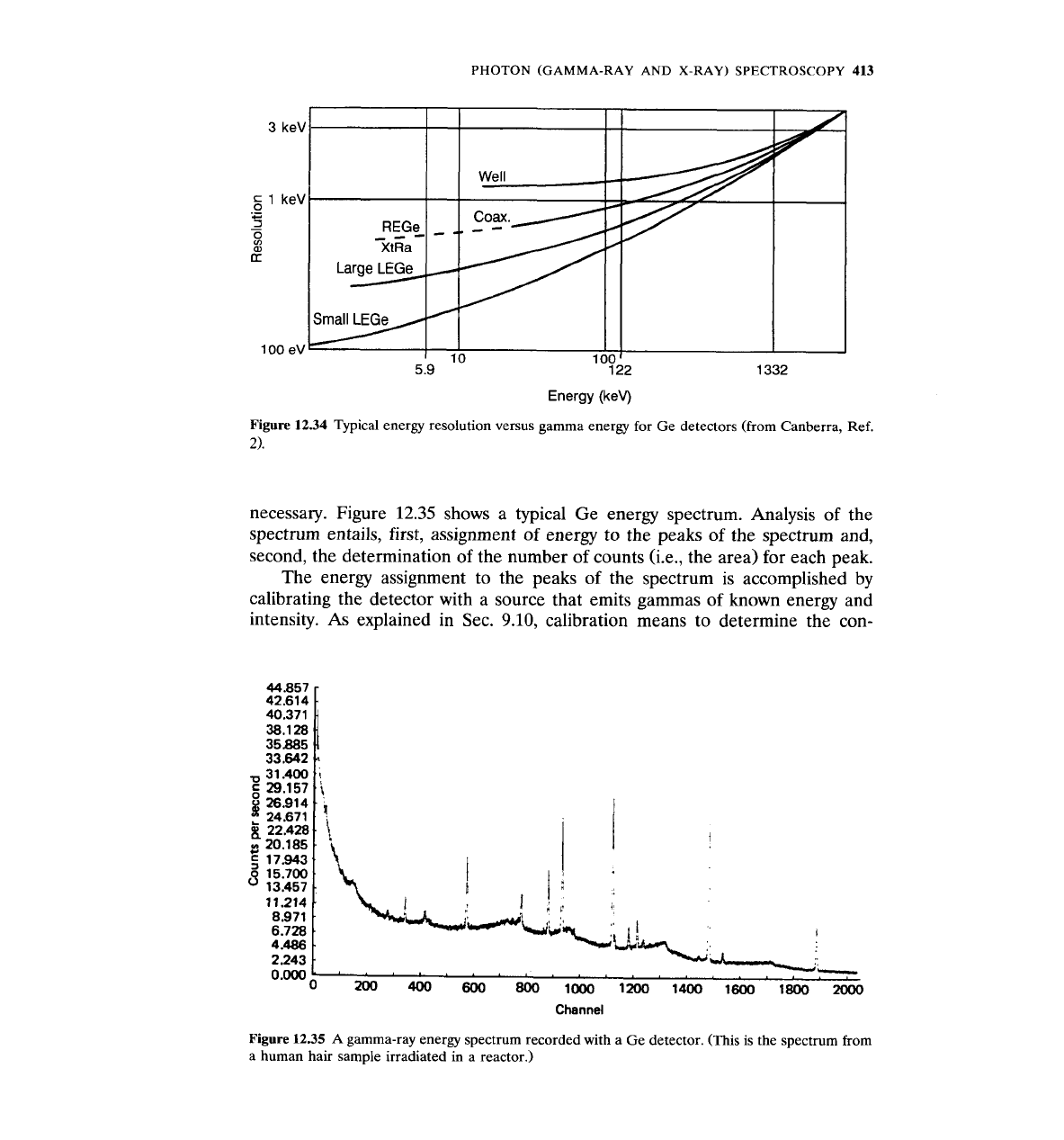
PHOTON
(GAMMA-RAY
AND
X-RAY)
SPECTROSCOPY
413
5
1
keV
.-
C
3
-
B
a,
[r
Large LEGe
Energy (keV)
Figure
12.34
Typical energy resolution versus gamma energy for Ge detectors (from Canberra, Ref.
2).
necessary. Figure
12.35
shows a typical Ge energy spectrum. Analysis of the
spectrum entails, first, assignment of energy to the peaks of the spectrum and,
second, the determination of the number of counts
(i.e., the area) for each peak.
The energy assignment to the peaks of the spectrum is accomplished by
calibrating the detector with a source that emits gammas of known energy and
intensity. As explained in Sec.
9.10,
calibration means to determine the con-
Channel
Figure
12.35
A
gamma-ray energy spectrum recorded with a Ge detector. (This is the spectrum from
a human hair sample irradiated
in
a reactor.)
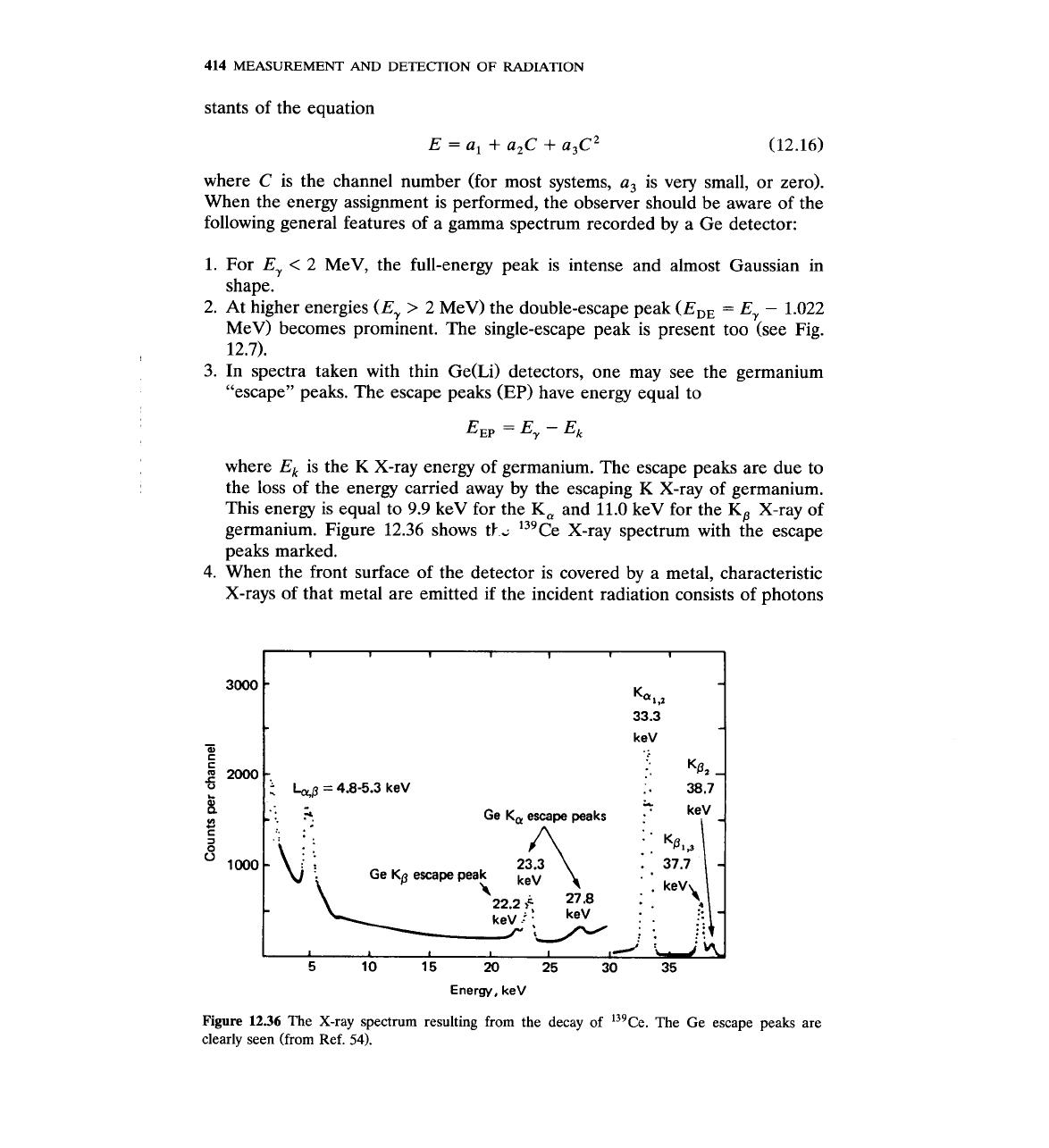
414
MEASUREMENT AND
DETECITON
OF
RADIATION
stants of the equation
where
C
is the channel number (for most systems,
a,
is very small, or zero).
When the energy assignment is performed, the observer should be aware of the
following general features of a gamma spectrum recorded by a Ge detector:
1.
For
E,
<
2 MeV, the full-energy peak is intense and almost Gaussian in
shape.
2. At higher energies (E,
>
2 MeV) the double-escape peak (ED,
=
E,
-
1.022
MeV) becomes prominent. The single-escape peak is present too (see Fig.
12.7).
3. In spectra taken with thin Ge(Li) detectors, one may see the germanium
"escape" peaks. The escape peaks
(EP)
have energy equal to
where
Ek
is the
K
X-ray energy of germanium. The escape peaks are due to
the loss of the energy carried away by the escaping
K
X-ray of germanium.
This energy is equal to
9.9
keV for the
K,
and 11.0 keV for the
KO
X-ray of
germanium. Figure 12.36 shows tk,: 13'Ce X-ray spectrum with the escape
peaks marked.
4. When the front surface of the detector is covered by a metal, characteristic
X-rays of that metal are emitted if the incident radiation consists of photons
?
keV
1
ie
K,
escape peaks
.
23.3
Ge
Kp
escape peak
keV
keV\
5
10
15
20
25
30
35
Energy,
keV
Figure
12.36
The X-ray spectrum resulting from the decay of '39~e. The Ge escape peaks are
clearly seen (from Ref.
54).
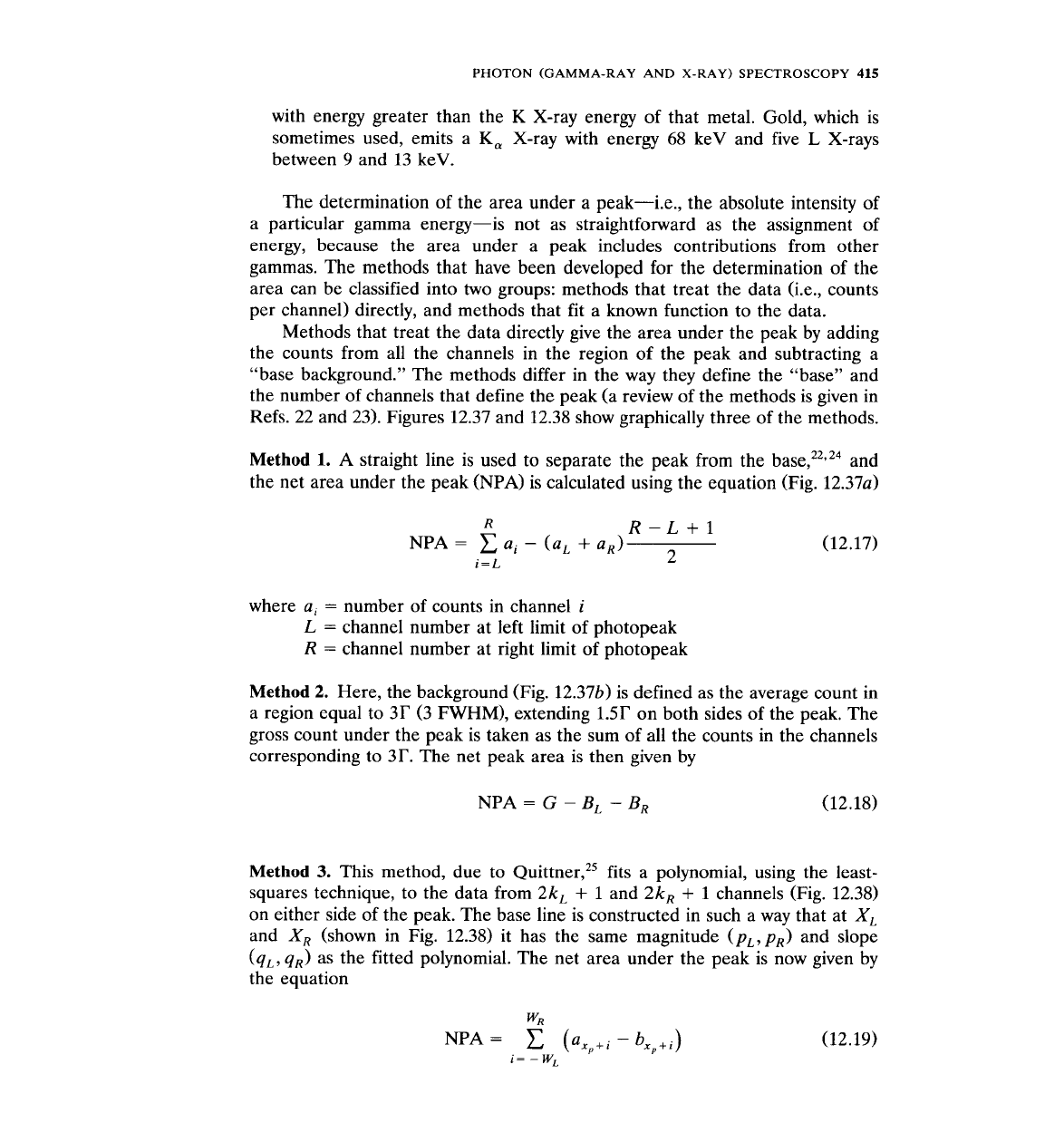
PHOTON
(GAMMA-RAY
AND
X-RAY)
SPECTROSCOPY
415
with energy greater than the
K
X-ray energy of that metal. Gold, which is
sometimes used, emits a
K,
X-ray with energy 68 keV and five
L
X-rays
between
9
and 13 keV.
The determination of the area under a peak-i.e., the absolute intensity of
a particular gamma energy-is not as straightforward as the assignment of
energy, because the area under a peak includes contributions from other
gammas. The methods that have been developed for the determination of the
area can be classified into two groups: methods that treat the data (i.e., counts
per channel) directly, and methods that fit a known function to the data.
Methods that treat the data directly give the area under the peak by adding
the counts from all the channels in the region of the peak and subtracting a
"base background." The methods differ in the way they define the "base7' and
the number of channels that define the peak (a review of the methods is given in
Refs. 22 and 23). Figures 12.37 and 12.38 show graphically three of the methods.
Method
1.
A straight line is used to separate the peak from the ba~e,'~.'~ and
the net area under the peak (NPA) is calculated using the equation (Fig. 12.37~)
R
R-L+1
NPA
=
C
a,
-
(a,
+
a,)
r,
where a,
=
number of counts in channel
i
L
=
channel number at left limit of photopeak
R
=
channel number at right limit of photopeak
Method
2.
Here, the background (Fig. 12.373) is defined as the average count in
a region equal to 3r (3 FWHM), extending
1.T
on both sides of the peak. The
gross count under the peak is taken as the sum of all the counts in the channels
corresponding to 3r. The net peak area is then given by
Method
3.
This method, due to ~uittner,'~ fits a polynomial, using the least-
squares technique, to the data from 2kL
+
1
and 2kR
+
1
channels (Fig. 12.38)
on either side of the peak. The base line is constructed in such a way that at
X,
and XR (shown in Fig. 12.38) it has the same magnitude (p,,p,) and slope
(q,, q,) as the fitted polynomial. The net area under the peak is now given by
the equation
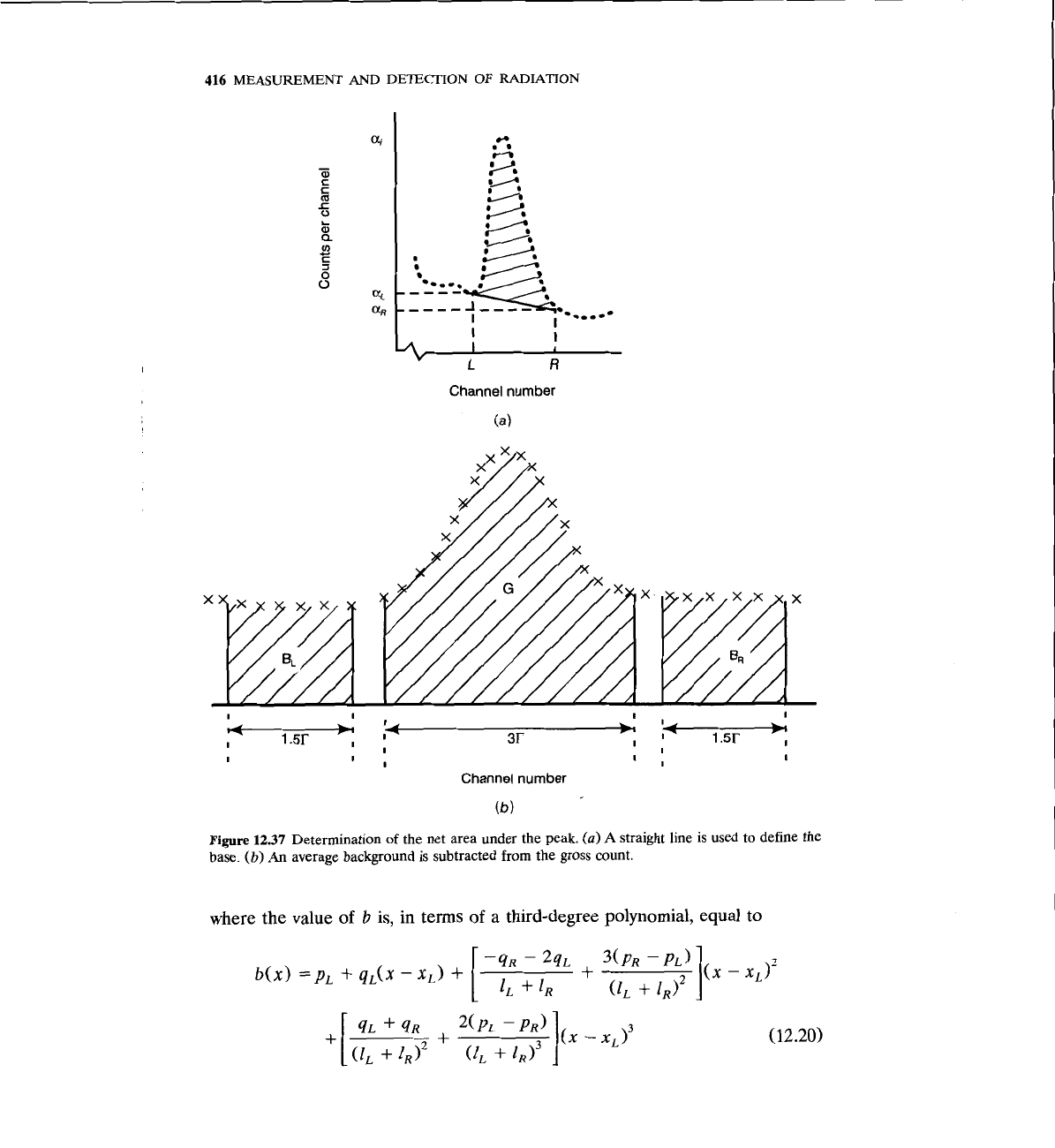
416
MEASUREMENT AND DETEmON OF RADIATION
Channel number
(a)
Channel number
Figure
12.37
Determination of the net area under the peak.
(a)
A
straight line is used to define the
base.
(b)
An
average background is subtracted from the gross count.
where the value of
b
is,
in
terms of a third-degree polynomial, equal to
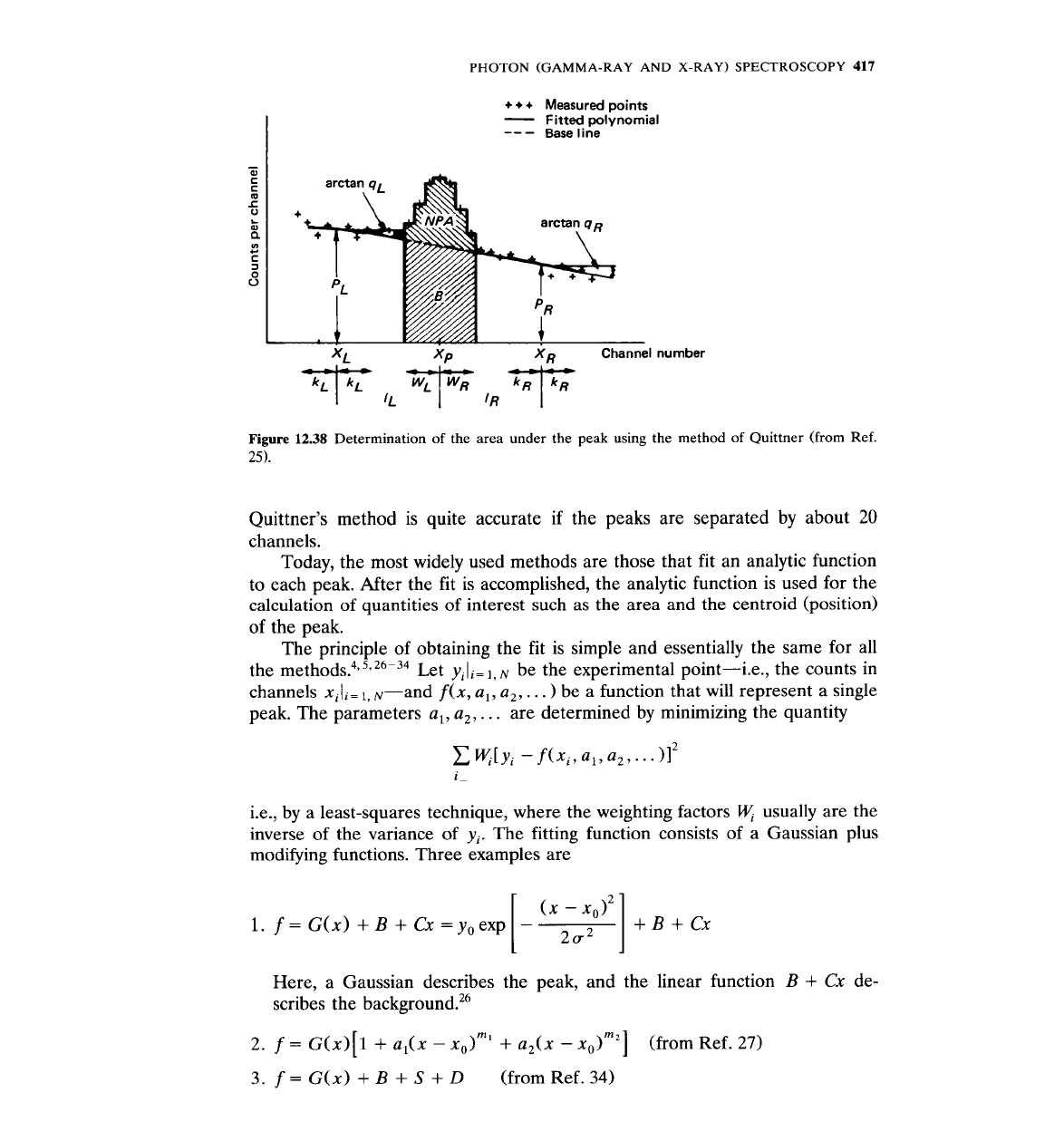
PHOTON
(GAMMA-RAY
AND
X-RAY)
SPECTROSCOPY
417
+ +
+
Measured points
-
Fitted
polynomial
--
-
Base
line
XR
Channel number
Figure
12.38
Determination of the area under the peak using the method of Quittner (from Ref.
25).
Quittner's method is quite accurate if the peaks are separated by about
20
channels.
Today, the most widely used methods are those that fit an analytic function
to each peak.
After the fit is accomplished, the analytic function is used for the
calculation of quantities of interest such as the area and the centroid (position)
of the peak.
The principle of obtaining the fit is simple and essentially the same for all
the meth~ds.~,
5,26G34
Let yili=
1,
N
be the experimental point-i.e., the counts in
channels xi(,= N-and f(x, a,, a,,
. .
.
)
be a function that will represent a single
peak. The parameters
a,,
a,,
.
. .
are determined by minimizing the quantity
C
y[yi
-
f(xi, a,, a,,
. .
.)12
1
i.e., by a least-squares technique, where the weighting factors
y
usually are the
inverse of the variance of y,. The fitting function consists of a Gaussian plus
modifying functions. Three examples are
Here, a Gaussian describes the peak, and the linear function
B
+
Cx de-
scribes the ba~kground.,~
2.
f
=
~(x)[l
+
aI(x
-
x.)~'
+
a2(x
-
x~)~~]
(from Ref.
27)
